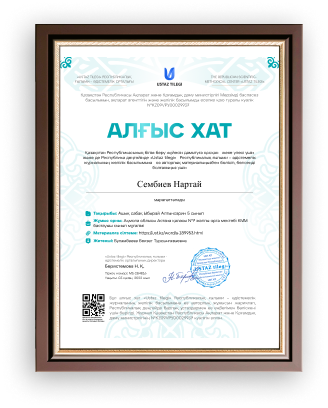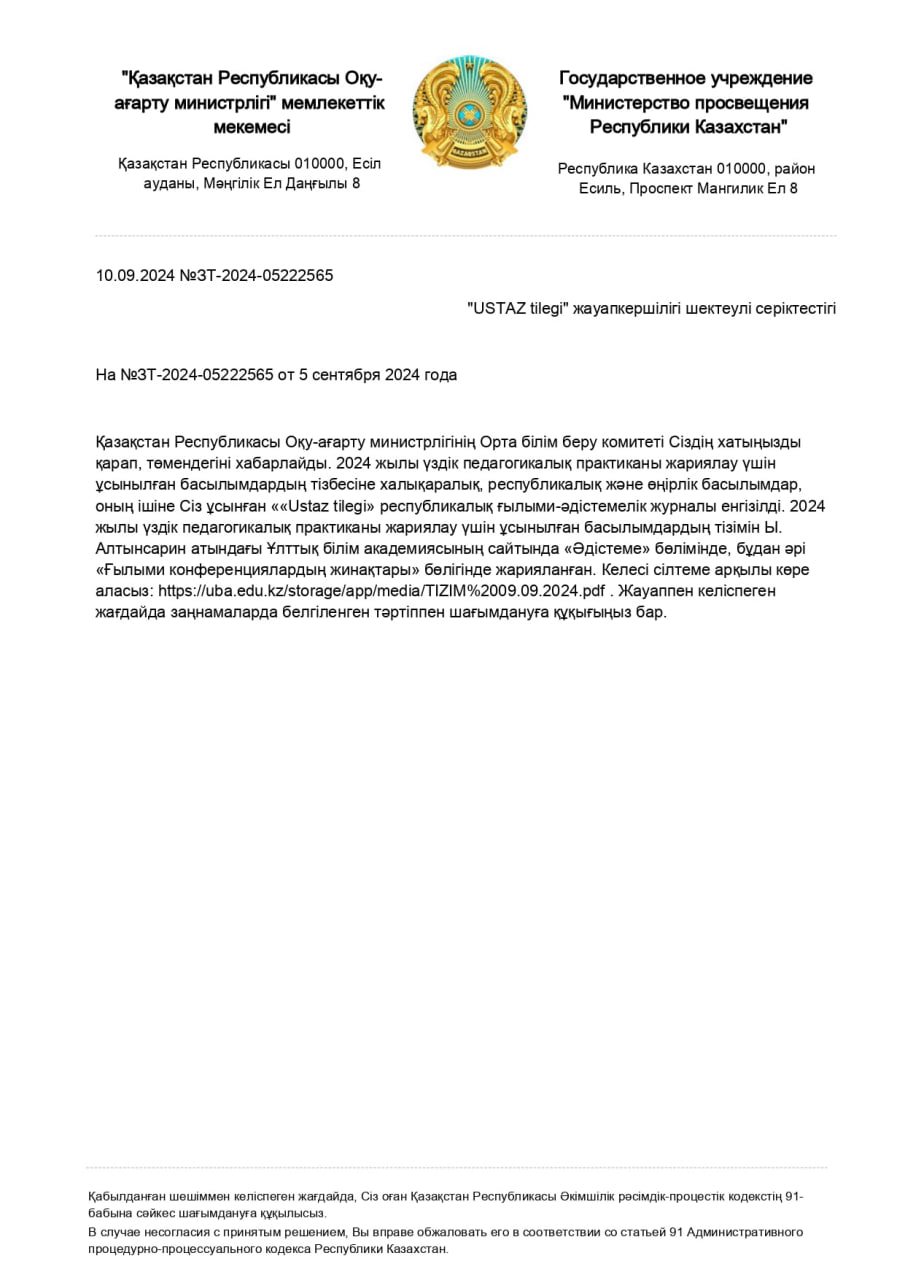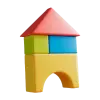|
Unit of a long term
plan:
Unit 5
Our Health.Lesson plan
51
|
School:№53
G.Musirepov
|
|
Date: 15.01.2019y
|
Teacher's name: Nurgalieva
U
|
|
CLASS: 6 “Ә,Б”
|
Number present:
|
absent:
|
|
Lesson title
|
Language
Focus.Canfor ability and
permission.
|
|
Learning objectives(s)
|
6.C1 use speaking and listening skills to solve
problems creatively and cooperatively in groups
6.C9 use imagination to express thoughts,
ideas, experiences and feelings
6.UE 13
use might may could to express possibility on a limited range
of familiar general and curricular topics
6.S2 ask simple questions to get information
about a limited range of general topics
6.S3
give an
opinion at sentence level on a limited range of general and
curricular topics
6.
6.S7 use
appropriate subject-specific vocabulary and syntax to talk about a
limited range of general topics
6.W8 spell most high-frequency words accurately
for a limited range of general topics
|
|
Lesson objectives
|
All
learners will be able to:
-
Identify the
theme, new words and use them as the basis for
discussion.
-
Demonstrate knowledge for usage
of the modal verb "can" for ability and
permission, making stories about
abilities.Transfer
information from the given
information into
a graphic organizer.
Most learners will
be able to:
-
Select,
compile, and synthesize information for an oral
presentation
-
Provide a point of view in
conversations and discussions; speak about people's
abilities.
Some learners will
be able to:
-
Respond to
and discuss the reading
passage using interpretive,
evaluative and creative thinking skills.
-
Make a presentation about
your
activities at school and after school.
|
|
Level of
thinking
|
Higher order thinking
skills (according to the revised Bloom's
taxonomy).
|
|
Assessment
criteria
|
-
Read the
given text of description and identify the general
information.
-
Demonstrate
skills of organizing and expressing ideas
accurately.
-
Illustrate a viewpoint
in a discussion.
|
|
Target
language
|
Play the piano, go into town, speak
languages, make questions, play an instrument, dance the tango,
stay out late.
|
|
Values links
|
Responsibility, Global
Citizenship, Respect and Love to people and school, abilities and
permission.
|
|
Cross-curricular links
|
Social Science,
Psychology, Information Technology, Art.
|
|
Previous learning
|
Vocabulary relating to
people's activity, school and school subjects.
|
|
Plan
|
|
Planned timings
|
Planned activities (replace the notes
below with your planned activities)
|
Resources
|
|
Start
3
min
Main part
15 min
|
Class organisation

.
We have got eyes and
we can see.
We have got ears and we can hear.
We have got legs and we can walk.
We have got mouths and we
can talk.

Быстро бегать как спортсмен
Я умею,yes, I CAN.
Lead-in (W,
I)
Ex.1 - 2
p.59
|
Ability:
physical /
mental
|
Permission
|
|
can
swim
|
can speak
Spanish
|
|
|
|
|
|
|
|
|
|
Write
about your abilities:
I
can........
I
can't..........
What can you
and your friend do?
Can you do
the same things?

In groups of 3, make a
presentation about your
class.
What can your class
do?
Ex.3 - 4
p.59.
Present your abilities as a
whole class.
INTRODUCTION OF A
RULE: If you want to ask for
permission, you put a modal verb can or
could on the first
place. Could is a more polite
form.
Could you show me the way to
the London Bridge?
No, sorry, you
can't.
Why not? Yes, you
can.
Look at the key phrases and
complete a dialogue: Ex.5.p.59
Keys: 1. you can't, 2.Why not,
3.Is it OK? 4. can I, 5. you can.
Make up your own dialogue and
play it in front of us.
The teacher asks Sts. to
write: What can they do at home and what can't they
do?
-
|
|
Yes
|
No
|
|
Sing
|
|
|
|
Dance
|
|
|
|
Fly
|
|
|
|
Ride a
bike
|
|
|
|
Play
football
|
|
|
Read the
poem and show the abilities:
"We
can"
We
can
We can jump and play the
drum.
We can draw our Dad and Mum
We can play and we can run.
We can have a lot of fun.
We can swim and we can sing -
It is very interesting!
|
Slide (useful
phrases)
Pictures
PPT
Writing
Worksheet
-
The picture of
activities at school a school
Writing
Worksheet
|
|
End
3 min.
|
Home
task:
W.B. p.41
Students express their
attitude to the lesson and give self-assessment using
the method:
“Six thinking
hats”:
-
Green: How can you use
today's learning in different subjects?
-
Red: How do you feel
about your work today?
-
White: What have you
leant today?
-
Black: What were the
weaknesses of your work?
-
Blue: How much progress
have you made in this lesson? (Now I can, I still need to work on,
I've improved in, Today I learnt... )
-
Yellow: What did you
like about today's lesson?
|
Slide
(Homework)
Slide "Six thinking
hats"

|
|
Additional information
|
|
Differentiation – how do you plan to
give more support? How do you plan to challenge the more able
learners?
|
Assessment – how are you planning to
check learners’ learning?
|
Health and safety check
|
|
Differentiation
can be
achieved
through content (Based on the theory
of Multiple Intelligences different tasks are
used with the same text).
By
support:
Less able
learners will be supported
through step-be-step instructions, glossaries, thinking
time.
By
task:
For
more
able learners additional leveled
tasks are offered.
|
Assessment
criteria:
-
Read the given passage
and identify the general information.
-
Demonstrate skills of
organizing and expressing ideas accurately.
-
Illustrate a viewpoint
in a discussion.
Descriptors:
A
learner
-
reads the text
for global understanding;
-
selects meaningful
information, constructs the answer;
-
presents information in the group
discussion.
-
evaluates the peers’
answers.
Teacher's observation
using observation checklist (Appendix 2 - reference to the resource
"Literature Circle Role Sheets" by Christine Boardman Moen.
p.28) and monitoring.
Self-assessment.
|
Health saving
technologies.
Make sure power cords are not a
tripping hazard
Everyday classroom precautions
|






















